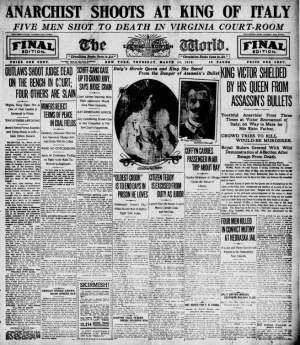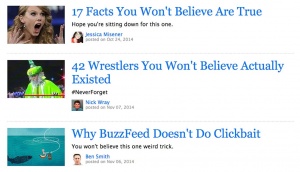Clickbait
Clickbait refers to a certain kind of web content advertisement designed to entice its readers into clicking an accompanying link. They are usually found in journalism and social media sites in the form of short teaser messages [1] that are designed to attract attention. They encourage people to click on them without giving much information about what the reader is going to find next and are often filled with stories that are fake, opinion-based, with little-to-no research done to back up the author’s points.[2][3] Online news media outlets rely heavily on page views to generate ad revenue and use clickbaits to increase the amount of people that visit their page. [4][5] The presence of clickbaits online creates many ethical concerns as they threaten to clog up social media and news source channels, causing negative experiences and creating misinformed users.
Contents
History

The presence of clickbaits have been present as early as the 19th century where political cartoons were displayed to attract the attention of the readers. Clickbaits were also present in early 19th century journalism where newspaper titles made provoking headlines to make people buy them instead of other newspaper. [6] The emergence of clickbait in tabloid journalism [4] and have put pressure on legacy media because of the competition for readers and revenue.[7] There has been many research conducted to understanding the psychological appeal of clickbait, and methods for identification have recently gained popularity. Social media websites have recognized the issues surrounding clickbait and have made several attempts to be able to recognize them quickly and prevent them from spreading.
Advertising Revenue
Backlash
Social media networks such as Facebook has recognized the problem and has made efforts to improve their newsfeed to "help people find the posts and links from publishers that are most interesting and relevant, and to continue to weed out stories that people frequently tell us are spammy and that they don’t want to see".[2] Facebook has attempted to remove clickbaits by measuring their click-to-share ratio[4], identifying phrases that are commonly used in clickbait headlines,[8] [9] and identifying clickbaits by measuring the amount of time that the user spend on the website after clicking the link. [2] Other scholars have also developed clickbait detection models and extensions to further help decrease how often they appear[1][4] as well as developed tips for analyzing news sources to distinguish real from fake news. [10]
Types
Exaggeration
Title exaggerating the content on the landing page.
Example: Cringeworthy tattoos that will destroy your faith in humanity
Teasing
Omission of details from title to build suspense: teasing.
Example: “Here’s Why Hillary Clinton Is ‘Deeply Worried’ About The UN’s Damning Climate Report”
Inflammatory
Either phrasing or use of inappropriate/vulgar words.
Example: Putin Punched at G20 Summit.
Formatting
Overuse of capitalization/punctuation, particularly ALL CAPS or exclamation points.
Example: EXCLUSIVE: Top-Secret Method allowed a mother to break the world record: 12kg in 4 weeks!
Graphic
Subject matter that is salacious or disturbing or unbelievable.
Example: Donatella Versace plastic surgery overload: Waxy face re-sembles melting candle.
Bait-and-switch
The thing promised/implied from the title is not on the landing page: it requires additional clicks or just missing.
Example: Beers Americans No Longer Drink.
Ambiguous
Title unclear or confusing to spur curiosity.
Example: Hands on: Samsung’s iPhone 5 is absolutely beautiful.
Wrong
Just plain incorrect article: factually wrong.
Example: Scientist Confesses: “Global Warming a $22 Billion Scam/center"
Ethical concerns
Clickbait headlines typically aim to "exploit a “curiosity gap” by providing just enough information to make a reader curious, but not enough to satisfy that curiosity".[11][12] The headlines are aimed at altering the emotions of the user, and if they fall for a clickbait it often leads to negative experiences. The presence of clickbaits in social media are also creating an increase in fake news where large proportions of social media users are uneducated on how to distinguish fake news sources from genuine news sources, which in turn create filter bubbles of misinformed users.
Negative experiences
Negative experiences are created when the user encounters a clickbait and has high expectations than what the article contains.[13][14]. Clickbaits rely on emotions to attract viewers and often create headlines that cause anger, anxiety, humor, excitement, inspiration, or surprise.[15] Upon visiting the article, many people are disappointed because they are often grammatically incorrect and the content found inside does not correspond to the title. Clickbaits can also lead to frustration because of their rate of occurrence on news feeds.
Fake news and misinformed users
Main article: Fake News
People are now using social media as their only way of acquiring news and many people do not know how to adequately identify genuine news sources [16] making them vulnerable to believing clickbaits when they encounter one. Clickbait often take bits of true stories but insinuate and make up other details to make the users react to them and their success is due to the large amounts of views and shares they receive. Clickbait are hard often hard to distinguish from real news sources because their format is manipulated to resemble credible journalism. Clickbait are notorious for spreading misinformation[17] and if users believe the content of the clickbait chances are they are going to share it with their own network. This further popularizes the clickbait and presents it to a larger number of users who could do the same, creating filter bubbles of misinformed users [18] who are often not educated on how to distinguish fake from real news sources.
References
- ↑ 1.0 1.1 Potthast, Martin; Köpsel, Sebatian; Stein, Benno; Hagen, Matthias (2016). ClickBait Detection Bauhaus-Universität Weimer
- ↑ 2.0 2.1 2.2 The Washington Post website: "What is ‘click bait’ and why Facebook wants to display less of it" https://www.washingtonpost.com/news/technology/wp/2014/08/26/what-is-click-bait-and-why-facebook-wants-to-display-less-of-it/?utm_term=.eccfff2e28b8
- ↑ Tech Crunch: "*** is a clickbait "https://techcrunch.com/2016/09/25/wtf-is-clickbait/"
- ↑ 4.0 4.1 4.2 4.3 Chakraborty, Abhijnan; Paranjape, Bhargavi; Kakarla, Sourya; Ganguly, Niloy (2016). Stop Clickbait: Detecting and Preventing Clickbaits in Online News Media Cornell University Library
- ↑ The dirty secrets of clickbait. This post will blow your mind! "https://econsultancy.com/blog/64399-the-dirty-secrets-of-clickbait-this-post-will-blow-your-mind/"
- ↑ A History of Clickbait: The First 100 Years http://io9.gizmodo.com/a-history-of-clickbait-the-first-100-years-1530683235
- ↑ PBS website: "Column: Why click-bait will be the death of journalism" http://www.pbs.org/newshour/making-sense/what-you-dont-know-about-click-bait-journalism-could-kill-you
- ↑ Facebook newsroom website: "News Feed FYI: Further Reducing Clickbait in Feed"http://newsroom.fb.com/news/2016/08/news-feed-fyi-further-reducing-clickbait-in-feed/
- ↑ engadget: "Facebook is ramping up its fight against clickbait"https://www.engadget.com/2016/08/04/facebook-is-ramping-up-its-fight-against-clickbait/
- ↑ "False, Misleading, Clickbait-y, and Satirical “News” Sources" https://d279m997dpfwgl.cloudfront.net/wp/2016/11/Resource-False-Misleading-Clickbait-y-and-Satirical-%E2%80%9CNews%E2%80%9D-Sources-1.pdf
- ↑ Curiosity Has the Power to Change Behavior for the Bette "http://www.apa.org/news/press/releases/2016/08/curiosity-behavior.aspx"
- ↑ Wikipedia: Clickbaits https://en.wikipedia.org/wiki/Clickbait
- ↑ Prakhar Biyani; Kostas Tsioutsiouliklis; John Blackmer (2016). “8 Amazing Secrets for Getting More Clicks”: Detecting Clickbaits in News Streams Using Article Informality Yahoo Labs
- ↑ The Ethics of Clickbait "http://wegobusiness.com/the-ethics-of-clickbait/"
- ↑ You’ll Be Outraged at How Easy It Was to Get You to Click on This Headline "https://www.wired.com/2015/12/psychology-of-clickbait/"
- ↑ "How We Broke Democracy" https://medium.com/@tobiasrose/empathy-to-democracy-b7f04ab57eee#.ocvg9cr5u
- ↑ Click Bait Websites and the Age of Misinformation "https://jordandetmers.com/2014/09/11/click-bait-websites-and-the-age-of-misinformation/"
- ↑ Forget Facebook and Google, burst your own filter bubble http://www.digitaltrends.com/social-media/fake-news-and-filter-bubbles

